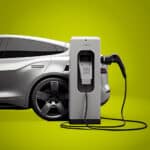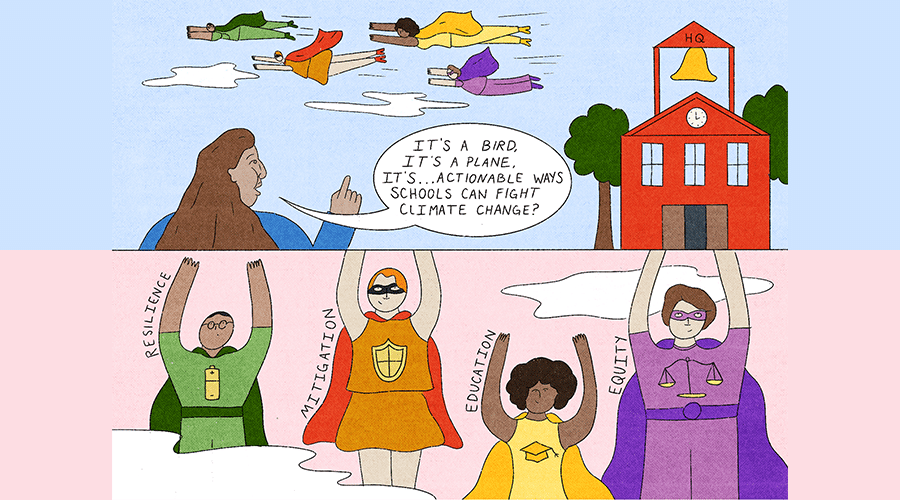We talk a lot about the role we all must play in tackling the climate crisis. There’s no shortage of work to be done, and no time for anyone to sit out—including the education sector.
K-12 schools have a hefty environmental footprint. Approximately 100,000 public K-12 schools sit on 2 million acres of land and are one of the largest public energy consumers. They also operate the largest mass transit fleet in the country, using 480,000 school buses. Schools also serve over 7 billion meals each year and generate 530,000 tons of food waste.
Recognizing that K-12 schools can play a key role in large-scale climate solutions, the Aspen Institute launched the K12 Climate Action initiative last fall. The project brings together education, environment, youth, civil rights leaders, and others to help elevate climate as a priority issue and create a comprehensive action plan to address climate change in the U.S. by leveraging the power of the education sector. Generation180 was one of the organizations in the coalition supporting this work.

Four Pillars of Climate Action
The K12 Climate Action Plan identifies four pillars of climate action: mitigation, adaptation, education, and advancement of equity.
Mitigate
There are many strategies highlighted in the action plan that schools can use to lower their environmental footprints and reduce greenhouse gas emissions. These include reducing energy consumption from buildings, switching to electric school buses, minimizing and composting food waste, and improving water efficiency.
Aspen’s K12 action plan featured Generation180 data about the collective potential of schools to reduce their impact by using solar energy. Our research found that by the start of 2020, there were 6,839 solar public K-12 schools in the U.S., with a 144% growth rate in the last five years. Yet, only 7% of public schools currently use solar energy. About half of all states allow power purchase agreements, which enable third-party ownership and minimize upfront costs, enabling schools to reinvest into teacher pay and their students. Generation180 is beginning to broaden our work to help schools address the largest source of carbon emissions in this country: transportation. Ninety-four percent of school buses are powered by diesel engines, which create air pollution, harm student health, and impact academic performance and absenteeism. Students of color are disproportionately exposed to air pollution, contributing to higher rates of asthma and other health issues. Electrifying school buses saves schools money (a whopping $170,000 in lifetime savings), and helps students breathe cleaner air.
Adapt
The COVID-19 pandemic made it clear how school disruptions affect all communities. The increasingly widespread impacts of climate change are also interrupting student learning and harming student health. Schools can play a pivotal role in helping our communities adapt. Schools that adopt more resilient infrastructure — such as solar + battery storage microgrids, which allow schools to retain key functions when other buildings lose power — can be critical community hubs for providing shelter and other services during an emergency.
Educate
Educators have an opportunity to prepare the next generation to be better equipped to address climate change and succeed in the clean energy economy. All subjects can be connected to climate change to support teaching and learning about sustainability, the environment, and green jobs,—and to empower students to advance climate solutions.
For example, the NYC DOE, the largest school system in the nation, prepares its 1.1 million students for a future powered by clean energy through more than 250 solar projects that allow for hands-on, STEM learning opportunities for students.
Advancing Equity
The action plan recommends that school districts develop and implement comprehensive K-12 climate action plans. To keep equity in focus, the action plans must ensure the voices of communities most impacted by climate change are central to decision-making, including students.
Many districts around the country have already worked to prioritize sustainability and serve as models for climate action, such as Stockton Unified School District and Middlesex County Public Schools.
All Hands on Deck
Just like group projects in school require collaboration in order to succeed, so does this action plan.
The K-12 plan outlines policy recommendations at the local, state, and federal levels, including proposing that governments at all levels help schools create and implement their own individual climate action plans. Governments can also provide financial and technical support to help schools invest in clean energy solutions, like solar and electric buses. Interagency coordination is a critical piece of the K-12 climate action puzzle.
By mobilizing the education sector to prioritize and implement climate solutions, we can build lasting change to advance a more equitable, sustainable future for today’s students.
Want to learn more about how we seize this opportunity to transform our energy system and education system? Read the full K-12 action report here.















